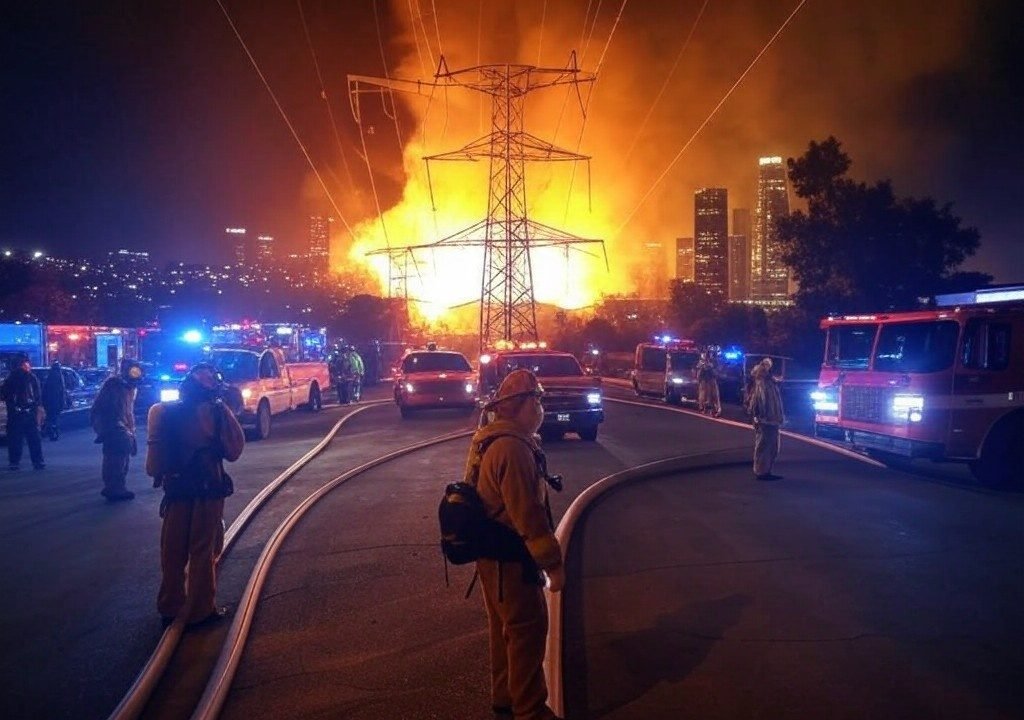Power Grid Faults and Their Potential Role in Recent Los Angeles County Wildfires
The recent wildfires in Los Angeles County, specifically the Eaton, Palisades, and Hurst fires, have raised serious concerns about the safety and reliability of the region’s power grid. A report from Whisker Labs, a company dedicated to monitoring electrical activity, reveals a shocking increase in faults on the power grid just hours before these devastating fires ignited. This article explores the correlation between electrical faults and wildfire risks, the potential implications for the future, and the necessity of robust monitoring systems.
The Alarming Data: Power Grid Faults Before the Fires
According to Bob Marshall, the CEO of Whisker Labs, the data indicates a direct correlation between the rise in electrical faults and the timing of the fires. In an interview with The Times, Marshall emphasized that the areas surrounding the Eaton, Palisades, and Hurst fires experienced a significant spike in power grid faults just before the flames erupted. These faults can be caused by several factors, including branches coming into contact with electrical wires or wires colliding with one another, resulting in sparks that could ignite surrounding vegetation.
Marshall stated, “What I cannot say is one of these faults sparked the fire. I don’t know that. But it just takes one to start the fire.” This uncertainty underscores the need for more comprehensive investigations into the causes of these wildfires.
Specific Numbers: Faults in the Hours Leading Up to the Fires
The data shared by Whisker Labs, although not yet publicly released, reveals alarming statistics. In the hour leading up to the Palisades fire, there were 25 faults recorded on the grid. When the fire broke out, another 18 faults were logged. The situation was even more critical in the vicinity of the Eaton fire, where 50 faults were recorded in the hour leading up to the ignition. Similarly, the Hurst fire saw 51 faults reported, following four hours of consistently high fault levels, amounting to 120 faults over that period. Marshall noted, “What we know is the lines were not de-energized prior to the ignition of fire.”
Utility Companies and the Need for Better Monitoring
Despite the evident risks posed by the electrical faults, Marshall pointed out a significant gap in utility companies’ infrastructure: “The problem is the utilities don’t have the sensors to know this is occurring.” Whisker Labs employs a sophisticated sensor network, the Ting sensors, which monitor around 14,000 homes in the Los Angeles area. These sensors not only help residents avert electrical fires in their homes but also aggregate data that provides a broader understanding of the power grid’s health.
Marshall’s assertion that “we have more information than they do” highlights the urgent need for utilities to invest in advanced monitoring technologies. Such enhancements could provide real-time data on grid stress, enabling proactive measures to prevent potential fire hazards.
Investigation into the Fires: A Multi-Factor Approach
The wildfires have not only destroyed numerous homes but also put a spotlight on the various factors that contribute to their ignition. Robert Garcia, the Angeles National Forest fire chief for the U.S. Forest Service, remarked at a recent news conference that while the cause of the Eaton fire is still under investigation, multiple factors are at play. “There’s a number of different activities in [Eaton Canyon],” Garcia explained. “There was public in there when it was occurring. And there’s power lines [that] run through there. So we have teams looking at all [possible starts].”
The complexity of wildfire ignition means that it is often challenging to pinpoint a single cause. In addition to electrical faults, human activities, weather conditions, and environmental factors all contribute to the risk of wildfires. The ongoing investigations by L.A. fire officials aim to unravel these complexities and determine the precise causes of the recent outbreaks.
Historical Context: Power Equipment and California Wildfires
California has a long history of wildfires being linked to power equipment. In recent years, several destructive fires have been attributed to electrical infrastructure failures. As climate change exacerbates dry conditions and increases the likelihood of wildfires, the scrutiny on utility companies has intensified. Critics argue that these companies must take more responsibility for maintaining their equipment and ensuring the safety of their operations.
In light of this historical context, the recent spike in electrical faults before the Los Angeles County fires raises critical questions about the adequacy of current safety protocols. The reliance on outdated monitoring systems could have dire consequences for communities in fire-prone areas.
The Role of Technology in Fire Prevention
The advances in technology, particularly in sensor and monitoring systems, hold immense potential for enhancing fire prevention efforts. Whisker Labs and similar organizations are paving the way for more comprehensive and responsive monitoring of the electrical grid. By providing granular data on electrical faults, these technologies can alert utility companies to potential risks in real-time, enabling them to take swift action to mitigate hazards.
Moreover, the integration of artificial intelligence and machine learning could revolutionize how utilities approach grid management and fire prevention. Predictive analytics could identify patterns and risks, allowing for more proactive measures to be implemented before a fire starts.
Conclusion: The Imperative for Proactive Measures
The dramatic rise in power grid faults preceding the recent wildfires in Los Angeles County raises significant concerns about the intersection of electrical infrastructure and wildfire risks. As Bob Marshall stated, it only takes one spark to ignite a fire, and the data indicates that the risks are not being adequately monitored or addressed. Moving forward, it is imperative for utility companies to invest in modern technologies that provide real-time insights into the health of the grid. By doing so, they can take proactive measures to prevent devastating wildfires, protect communities, and ensure a safer future for California residents. The integration of advanced monitoring systems will not only enhance public safety but also play a critical role in safeguarding the environment and the economy from the ravages of wildfires.





